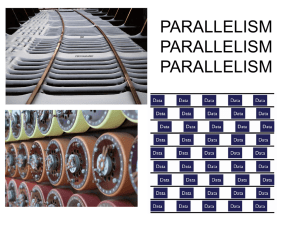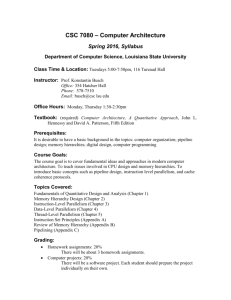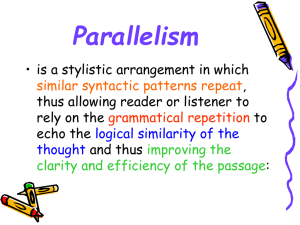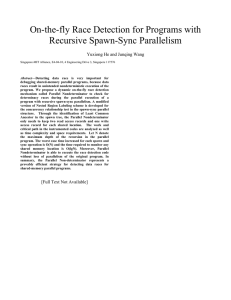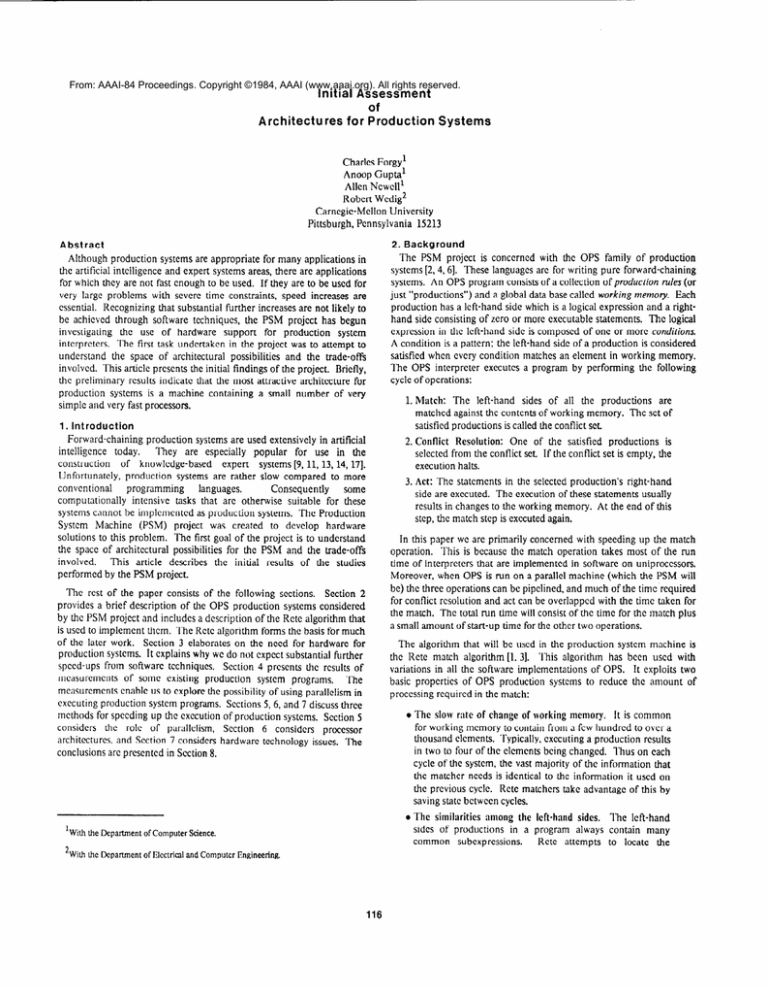
From: AAAI-84 Proceedings. Copyright ©1984, AAAI (www.aaai.org). All rights reserved.
Initial
Architectures
Assessment
of
for Production
Systems
Charles Forgy’
Anoop Guptal
Allen Newell’
Robert Wedig’
Carncgic-Mellon University
Pittsburgh, Pennsylvania 15213
Abstract
2. Background
Although production systems are appropriate for many applications in
the artificial intelligence and expert systems areas, there are applications
for which they are not fast enough to be used. If they are to be used for
very large problems with severe time constraints, speed increases are
essential. Recognizing that substantial further increases are not likely to
be achieved through software techniques, the PSM project has begun
investigating the use of hardware support for production system
interpreters. The first task undertaken in the project was to attempt to
understand the space of architectural possibilities and the trade-offs
involved. This articlc presents the initial findings of the project. Briefly,
the preliminary results indicate that the most attractive architecture for
production systems is a machine containing a small number of very
simple and very fast processors.
The PSM project is concerned with the OPS family of production
systems [2,4, 61. These languages arc for writing pure forward-chaining
systems. An OPS program consists of a collection of produclion rules (or
just “productions”) and a global data base called working memory. Each
production has a left-hand side which is a logical expression and a righthand side consisting of zero or more executable statements. The logical
expression in the left-hand side is composed of one or more con&ions.
A condition is a pattern; the left-hand side of a production is considered
satisfied when cvcry condition matches an element in working memory.
The OPS interpreter executes a program by performing the following
cycle of operations:
1. Int reduction
Forward-chaining production systems are used extensively in artificial
intelligence today.
They are especially popular for use in the
construction
of knowledge-based
expert systems [9,11,13,14,17].
Unfortunately, production systems are rather slow compared to more
conventional
programming
languages.
Consequently
some
computationally intensive tasks that arc otherwise suitable for these
systems cannot be implemcntcd as production systems. The Production
System Machine (PSM) project was created to dcvclop hardware
solutions to this problem. The first goal of the project is to understand
the space of architectural possibilities for the PSM and the trade-offs
involved.
This article describes the initial results of the studies
performed by the PSM project.
The rest of the paper consists of the following sections. Section 2
provides a brief description of the OPS production systems considered
by the PSM project and includes a description of the Rctc algorithm that
is used to implement them. The Rctc algorithm forms the basis for much
of the later work. Section 3 elaborates on the need for hardware for
production systems. It explains why WCdo not cxpcct substantial further
speed-ups from software tcchniqucs. Section 4 prcscncs the results of
mcasurcmcnts of some existing production system programs.
The
mcasurcmcnts cnablc US to cxplorc the possibility of using parallelism in
executing production system programs. Sections 5, 6, and 7 discuss three
methods for speeding up the execution of production systems. Section 5
considers the role of parallelism, Section 6 considers processor
architectures. and Section 7 considers hardware technology issues. The
conclusions arc presented in Section 8.
‘With the
2
With
DcpaNnentof ComputerScience.
the Departmentof Electricaland ComputerEngineering.
1. Match: The left-hand sides of all the productions are
matched against the contents of working memory. The set of
satisfied productions is called the conflict set
2. Conflict Resolution: One of the satisfied productions is
selected from the conflict set If the conflict set is empty, the
execution halts.
3. Act: The statements in the selected production’s right-hand
side are executed. The execution of these statements usually
results in changes to the working memory. At the end of this
step, the match step is executed again.
In this paper WCarc primarily concerned with speeding up the match
operation. This is because the match operation takes most of the run
time of interpreters that are implemented in software on uniproccssors.
Moreover, when OPS is run on a parallel machine (which the PSM will
be) the three operations can be pipclined, and much of the time required
for conflict resolution and act can be overlapped with the time taken for
the match. The total run time will consist of tbc time for the match plus
a small amount of start-up time for the other two operations.
The algorithm that will be used in the production system machine is
the Rcte match algorithm [I, 31. This algorithm has been used with
variations in all the software implementations of OPS. It exploits two
basic propertics of OPS production systems to reduce the amount of
processing required in the match:
l
It is common
for working memory to contain from a few hundred to over a
thousand clemcnts. Typically, cxccuting a production results
in two to four of the clcmcnrs being changed. Thus on each
cycle of the system, the vast majority of the information that
the matcher needs is identical to the information it used on
the previous cycle. Rcte matchers take advantage of this by
saving state bctwcen cycles.
l
The similarities among the left-hand sides. The lcfi-hand
sides of productions in a program always contain many
common subcxprcssions.
Rctc attempts to locate the
The slow r:ltc of change of working memory.
speed-up of OPS83 rcsultcd primarily from a new method of compiling
left-hand sides. In all earlier versions of OPS, the left-hand sides were
compiled into an intcrmcdiate representation that had to be interpreted
at run time; in OPS83, the left-hand sides are compiled into native
machine code.
common subexprcssions. so that at run-time the matcher can
evaluate each of thcsc expressions only once.
The Rete interpreter processes the l&-hand sides of the productions
prior to executing the system. It compiles the lcfi-hand sides into a
network that specifies the computations that the matcher has to perform
in order to effect the mapping from changes in working memory to
changes in the conflict set. The network is a dataflow graph. The input
to the network consists of changes to working memory encoded in data
structures called tokens. Other tokens output from the network specify
the changes that must be made to the conflict set. As the tokens flow
through the network, they activate the nodes, causing them to perform
the necessary operations, creating new tokens that pass on to subsequent
nodes in the network. The network contains essentially four kinds of
nodes:
l
It appears that with the advent of OPS83, further substantial
improvements in software techniques have become difficult to achieve.
Some amount of optimization of tbc compiled code is certainly possible,
but this is expected to result in rather small increases in speed compared
to what has occurred in recent years. The code that the OPS83 compiler
products is fairly good already. A factor of two speed-up due to
compiler optimi/ations might be achieved; a factor of five seems unlikely
at this time. Since the importance of achieving further speed increases
for OPS is so clearly indicated, we feel that it is essential to investigate
hardware support for OPS interpreters4
Constant-test nodes: These nodes test constant features of
working memory elements. They effectively implement a
sorting network and process each element added to or
deleted from working memory to determine which
conditions the elcmcnt matches.
l
Memory nodes: These nodes maintain the matcher’s state.
They store lists of tokens that match individual conditions or
groups of conditions.
l
Two-input nodes: These nodes access the information stored
by the memory nodes to determine whether groups of
conditions are satisfied, For example, a two-input node
might access the lists of tokens that have been determined to
match two conditions of some production individually and
determine whether there are any pairs of tokens that match
the two conditions together. In general, not all pairs will
match because the left-hand side may specify constraints
such as consistency of variable bindings that have to hold
bctwccn the two conditions. When a two-input node finds
two tokens that match simultaneously, it builds a larger token
indicating that fact and passes it to subsequent nodes in the
network.
l
Terminal nodes: Terminal nodes arc concerned with changes
to the conflict set. When one of these nodes is activated, it
adds a production to or removes a production from the
conflict set. The processing pcrformcd by the other nodes
insures that these nodes arc activated only when conflict set
changes arc required.
4. Measurements
of Production
Systems
One of the first tasks undertaken by the PSM group was to perform
cxtcnsive measurements of production systems running in OPS5. These
measurements were necessary to evaluate the possibilities for speeding
up Rete interpreters. Six systems were measured: R1[13], a program for
configuring VAX computer systems; XSEL 1141,a program which acts as
a salts assistant for VAX computer systems; PfRANS 191.a program for
factory managcmcnt; HAUNT, an advcnturc-game program dcvclopcd
by John I.aird; DAA [ll], a program for VlSl design; and SOAR [12],
an cxpcrimcntal problem-solving architecture implcmcntcd as a
production system. Ihc Rl, XSEL, and YI’RANS programs were chosen
bccausc they arc three of the largest production systems cvcr written, and
bccausc they arc actually being used as cxpcrt systems in industry. The
DAA program was chosen because it rcprcscnts a computation-intensive
task compared to the knowledge-intensive tasks pcrformcd by the
previous programs. The SOAR program was chosen bccausc it embodies
a new paradigm for the USCof production systems. Altogcthcr, the six
programs represent a wide spectrum of applications and programming
styles. The systems contain from 100 to 2000 productions and from 50 to
1000 working memory elements. A few of the more important results are
presented here; more detailed results can be found in [7].
The first set of measurements concern the surface characteristics of
production system programs-that is, the characteristics of the programs
that can be described without reference to the implementation
techniques used in the intcrpretcr. Table 1 shows the results. The first
line gives the number of productions in each of the measured programs5
The second line gives the average number of conditions per production.
The number of conditions in a production affects the complexity of the
match for that production. The third line gives the average number of
actions per production. The number of actions dctcrmincs how much
working memory is changed when a typical production fires. Together
these numbers give an indication of the size and complexity of the
productions in the systems. They show that productions are typically
simple, containing neither large numbers of conditions nor large
numbers of actions.
3. The Need for Hardware
The previous work on the cfftciency of OPS systems has conccntratcd
on software techniques. Over the past several years, improvements in the
software have brought about substantial speed incrcascs. The first LISPbased version of OPS was OPS2, which was implcmcntcd in 1978 (51.
The widely-used I,lSP version OPSS was implcmcntcd about 1980 [2].
The improvements in software technology during that time made OPSS
at least five to ten times faster than OPS2. OPSS/LISP has been
followed by two major reimplemcntations: an intcrprctcr for OPS5
written in BLISS (a systems programming language) and the OPS83
interpreter [6]. OPSS/BLISS is at least six times faster than OPSS/LISP,
and OPS83 is at lcast four times faster than OPS5/BLISS.3 The speed-up
from OPS2 to OPSS/BLISS rcsultcd from a number of factors, including
changing the rcprcsentations of the important data structures and putting
in special code to handle common cases efficiently. The additional
Feature
1. Productions
2. Conds/Prod
3. Actions/Prod
R1
1932
5.6
2.9
XSEL PTRANS
1443
1016
3.8
3.1
2.4
3.6
HAUNT
834
2.4
2.5
DAA
131
3.9
2.9
SOAR
103
5.8
1.8
Table 1: Summary of Surface Measurements
4
‘lhc DAD0 project at Columbia University is also investigating hardware support for
production systems [8, 181.
3
In absolute terms, a large production system with a large working memory and
moderately complex left-hand sides (e.g.. Rl [13]) might be expected to tun at a rale of one
to two production firings per second with OPWLISP
running on a VAX U/780; at a rate
of six to twelve firingsper secondwith OPWI3LISS; and a rate of twenty-live to fifty
firings per second with OPS83.
5
In someWCS only a subset of the complete production system program was measured
because of problems with the LISP garbage collector. ‘Ihc numbers given in the table
indicatethe number of productions in the subset of the program that was mcasurcd.
117
The second set of measurements relate to the run-time activity of the
OPSS interpreter. Table 2 shows how many nodes are activated on
average aI& each change to working memory. Line 1 shows the number
of constant-test nodes activated. Although constant-test node activations
constitute a large fraction (65%) of the total node activations, only a small
fraction (10% to 30%) of the total match time is spent in processing them.
This is bccausc the processing associated with constant-test nodes is very
simple compared to the memory nodes and the two-input nodes. Line 2
shows the number of memory nodes activated, and Line 3 the number of
two-input nodes. Most of the matcher’s time is spent evaluating these
two kinds of nodes. Lint 4 shows the number of terminal nodes
activated. Since thcsc numbers are small, updating the conflict set is a
comparatively inexpensive operation. Thcrc arc two major conclusions
that can be drawn from this table. First, except for the constant-test
nodes, the number of nodes activated is quite small. Second-and
perhaps more significantly-except
for the constant-test nodes, the
numbers are csscntially indcpcndent of the number of productions in the
system.6 This is important in the design of parallel production system
interpreters (see the discussion of parallelism below).
Node Tvne
1. Constant-test
2. Memory
3. Two-input
4. Terminal
a
136.3
12.3
47.1
1.0
XSEI,
105.3
8.7
32.4
1.7
P’TRANS HAUNT
122.1
88.5
10.7
12.5
35.0
36.8
1.7
1.5
DAA
35.9
4.0
22.2
2.0
to the number of productions containing conditions that match the
working memory clcmcnt. Thus, on avcragc, when an clement is added
to or dclctcd from working memory, the stored state for thirty-five
productions must be updatcd.7 ’l-he number of affected productions is
significant because most of the match time is devoted to these
Thus the immcdiatcly apparent upper bound to the
productions.
amount of speed-up from production-level parallelism is around thirtyfive. However, it is easy to see that this is a very optimistic upper bound.
Measurements show that it is common for a few of the affected
productions to require five or more times as much processing as the
average production. Thus in a machine that uses substantial amounts of
production-level parallelism, the match would be characterized by a brief
flurry of parallel activity followed by a long period when only a few
processors are busy. The average concurrency would be much lower
than the peak concurrency.
5.2. Condition-level
SOAR
26.5
11.1
39.5
4.0
Table 2: Node Activations per Working Memory Change
5. Parallelism
On the surface, the production system model of computation appears
to admit a large amount of parallelism. This is because it is possible to
perform match for all productions in parallel. Even after the left-hand
sides have been compiled into a Rctc network, the task still appears to
admit a large amount of parallelism, because different paths through the
network can be proccsscd in parallel. It is our current asscssmcnt,
however, that the speed-up available from parallelism in production
systems is much smaller than it initially appears.
5.3. Action-level
Parallelism
In action-lcvcl parallelism, all the changes to working memory that
occur when a production fires are processed in parallel. Action-level
parallelism dots not require any more data communication overhead
than the previous two sources of parallelism, but it dots involve a
substantial amount of extra synchronization overhead. The speed-up
possible from action-lcvcl parallelism is also quite limited. A typical
production makes two to four working memory changes, so the amount
of action-level parallelism available is at most two to four,
We are exploring three sources of parallelism for the match step in
production system programs: production-level, condition-level, and
action-level parallelism. In the following paragraphs we briefly describe
each of these three sources, and where possible give the speed-up that we
expect from that source.
5.1. Production-level
Paralle’lism
In condition-level parallelism, the match for each condition in the lefthand side of a production is handled by a separate process. Conditionlevel parallelism involves more communication
overhead than
production-level parallelism. It is now necessary to communicate tokens
matching one condition to processes that combine tokens, thus forming
new tokens matching several conditions in the left-hand side. This
increased communication
makes shared-memory
multiprocessors
preferable to non-shared memory multicomputers.
The speed-up
expected from condition-level parallelism is quite limited. This is
because productions tend to be simple, as Table 1 shows. Since the
typical production contains only three to six conditions, even when all
the conditions in an left-hand side have to be processed (a rare
occurrence) only three to six parallel processes can be run.
5.4.
Simulation
Results
To gain a more dctailcd evaluation of the potential for parallelism in
the interpreter, a simulator has been constructed, and simulations of the
execution of the XSFL, PI‘RANS, and DAh expert systems have been
run. The cost model assumed for the simulation is based on the costs
that have been computed for the OPS83 matcher. Since the OPS83
matcher would have to be modified somewhat in order to run in parallel,
the costs have been adjusted to take these modifications into account.
Parallelism
In production-lcvcl parallelism, the productions in the system are
divided into several groups and a separate process is constructed to
perform match for each group. All the processes can execute in parallel.
The extreme case for production-level parallelism is when the match for
each production is performed in parallel. The major advantage of
production-level parallelism is that no communication is required
between the processes performing the match, although the changes to
working memory must be communicated to all processes. Since the
communications rcquircments are very limited, both shared memory and
non-shared memory multiprocessor architectures can exploit productionlevel parallelism.
The graph in Figure 1 indicates the speed-up that is achieved through
the use of production-level, condition-level, and action-level parallelism.
As the graph shows, the speed-up obtained is quite limited. This is a
combined effect of the facts that (1) the processors must wait for all
affected productions to finish match before proceeding to the next cycle,
and (2) there is a large variance in the computational requirements of the
affected productions. The graphs show that a speed-up of four to six
times can be obtained with relatively good processor utilization, but to
obtain a larger factor requires much more hardware.
The mcasurcmcnts dcscribcd in Section 4 arc useful in determining the
amount of speed-up that is potentially available from production-lcvcl
parallelism. Line 3 of Table 2 shows that on average each change to
working memory causes about thirty-five two-input nodes to be
activated. Since the sharing of nodes at this lcvcl of the network is
limited, the number of two-input nodes activated is approximately equal
7Note that the number thirty-five is independent of the number of productions in the
program. An intuitive explanation for this is that programmers divide problems into
subproblems, and at any given time the program cxccution corresponds to solving only one
of these subproblcms. The size of the subproblems is indcpcndcnt of the size of the overall
problem and primarily dcpcnds on the complexity that an individual can deal with at the
same time.
6.
Ihcrc are known methods of reducing the cffcct of production system size on the
number of constant-test node activations (SW PI).
118
7. Device Technology
Since the correct choice for the machine appears to be a RISC-like
processor and rather modest levels of parallelism, we are exploring the
USCof high-speed logic families in its implementation, such as ECL or
GaAs. The difficulties inherent in the use of these technologies arc offset
to a large dcgrce by the fact that the machine will use relatively little
hardware. Certainly designing each component will be more dificult
than designing a similar component in 1TL or MOS; however the
machine will be fairly simple so the total design time will not be
excessive. In addition, while the processors will be more expensive than
processors implemented in slower tcchnologics, the machine will not
contain large numbers of them, and the total cost will not be excessive.
WC estimate an F,CL implementation of the machine would bc about
four times faster than a ?TL implcmcntation, provided the processor did
not spend too much time waiting on memory.
8. Conclusions
The PSM project is investigating rhc USCof hardware support for
production system intcrprctcrs. WC cxpcct to obtain speed increases
from three sources: parallelism, processor architccturc, and dcvicc
technology. Our studies arc not complctc, but some initial results are
available:
Figure 1: Parallelism in Production Systems
6. Processor
Architecture
Because of our expericncc with the Rctc network, we-have a good idea
of how a machine executing OPS will behave. In the Rcte network, there
are only a few different types of code scquenccs to deal with. By
calculating the time that a given processor requires to execute these
sequences, we can accurately dctcrminc how effective the pr&essor is for
this task. Typical code sequences from the Rete network are shown in
Figures 2 and 3. Figure 2 shows the computation pcrformcd by a
constant-test node. Figure 3 shows a loop from a two-input nod&. The
loop is cxccutcd when the two-input node compares a token from one
memory with the tokens in another memory.
load
Rl,“active”
cmp
jne
Rl,l(R.CurWme)
Ll
l
a Processor architecture: The most attractive architectures for
this task arc the simple (or so-called RISC) processors. We
estimate that a RISC machine would be 2 to 4 times faster
than a complex instruction set machine.
l
;load the constant
;compare the value
;if not equal, fail
Figure 2: Assembly Code for a Constant Test
move
jeq
RO,R.MPtrl
L2
;test
;exit
memory
if nil
load
jmp
R.MPtrl,NEXT(R.MPtrl);get
next
;continue
10s
;exit
L2
token
if not
Device technology: Since speed is of paramount importance
in this task, and since very simple processors arc appropriate,
it will be advantageous to use high-speed device technologies.
We estimate that using ECL would provide a factor of 4
increase in speed.
In summary then, a machine built along the lines we suggest would be
between 5 * 2 * 4 = 40 and 10 * 4 * 4 = 160 times faster than a complex
uniproccssor irnplementcd in a slower speed technology. It should be
emphasized that these arc preliminary results, and are subject to change
as the work proceeds.
pointer
lO$:load R.Wmel,WME(R.MPtrl) ;get the wme
;goto tests
jsb L3
jne
Parallelism: The task admits a modest amount of parallelism.
WC expect parallelism to contribute a 5 to 10 fold incrcasc in
speed.
nil
9. Acknowledgments
H. T. Kung, John McDermott,
substantially to this research.
Figure 3: Loop from a Two-input Node
As these code sequences illustrate, the computations performed by the
matcher are primarily memory bound and highly sequential. Each
instruction’s cxccution depends on the previous one’s, leaving little room
for concurrent execution of the instructions. Consequently, it is not
advantageous to develop a processor with multiple functional units able
to extract concurrency and simultaneously exccutc multiple instructions.
It is also not worthwhile to design a computer with a large range of
complex instructions and addressing modes since the majority of time is
spent executing simple operations. We conclude that a machine for
executing production systems should have a simple instruction set and
should execute the instructions in as few clock cycles as possible. The
processor designs that best satisfy these requirements are the reduced
instruction set (RISC) machines such as the Berkeley RISC [15], the
Stanford MIPS [lo], or the IBM 801[16]. Such a machine could execute
most instructions in two machine cycles. We estimate that a complex
insrruction set machine requires four to eight cycles per instruction,
making the simple machine two to four times faster.
and Kemal
Oflazer contributed
This research was sponsored by the Defense Advanced Research
Projects Agency (DOD), ARPA Order No. 3597, monitored by the Air
Force Avionics Laboratory under Contract F33615-81-K-00450.
References
1. Forgy, C. L. On ihe Efficient Impiemenfafions of Production Systems.
Ph.D. Th., Carnegie-Mellon University, 1979.
2. Forgy, C. L. OPS5 User’s Manual. Tech. Rept. CMU-CS-81-135,
Carncgic-Mellon University, 1981.
3. Forgy, C. L. “Rctc: A Fast Algorithm for the Many Pattern/Many
Object Pattern Match Problem.” Arlificial Intelligence 19 (September
1982).
4. Forgy, C. L. and McDermott, J. OPS, A Domain-Independent
Production System. International Joint Conference on Artificial
Intelligence, IJCAI-77.
5. Forgy, C. L. and McDermott, J. The OPS2 Reference Manual.
Dcpartmcnt of Computer Science, Carnegie-Mellon University, 1978.
6. Forgy, C. L. The OPS83 Report. Department of Computer Science,
Carnegie-Mellon University, May 1984.
119
7. Gupta, A. and Forgy, C. I-. Mcasurcmcnts on Production Systems.
Carncgic-Mellon University, 1983.
8. Gupta, A. lmplcmcnting OPS5 Production Systems on DADO.
lntcrnational Confcrcncc on Parallel Processing. August, 1984.
9. Halcy, P., Kowalski, J., McDermott, J., and McWhortcr, R.
FYfRANS: A Rule-fjascd Managcmcnt Assistant. In preparation,
Carncgic-Mellon University
10. Hcnncssy, J. L., ct al. The MIPS Machine. Digest of Papers from
the Computer Confcrcnce. Spring 82, February, 1982, pp. 2-7.
11. Kowalski, I’. and Thomas. 1). The VLSI Design Automation
Assistant: Prototype System. Proceedings of the 20th Design
Automation Confcrencc, ACM and IEEE, June, 1983.
12. I.aird, J. and Newell, A. A Universal Weak Method: Summary of
Results. International Joint Confcrcnce on Artificial Intelligence,
IJCAI-83.
13. McDermott, J. Rl: A Rule-based Configurcr of Computer Systems.
Tech. Rept. CMU-CS-80-119, Carncgic-Mellon University, April, 1980.
14. McDermott, J. XSEL: A Computer Salcspcrson’s Assistant. In
Afachine In/eiligence, J.E. Hayes, D. Michie, and Y.H. Pao,
Ed.,Horwood, 1982.
15. Patterson, D. A. and Sequin, C. H. “A VLSI RISC.” Conrpuler 9
(1982).
16. Radin, G. “The 801 Minicomputer.” IBM Journal of Research and
Developntenf 27 (May 1983).
17. Stolfo, S. J. and Vcsonder, G. T. ACE: An Expert System
Supporting Analysis and Management Decision Making. Department of
Computer Science, Columbia University, 1982.
18. Stolfo, S. J. and Shaw, D. E. DADO: A Tree-Structured Machine
Architecture for Production Systems. National Conference on Artificial
Intelligence, AAAI-1982.

